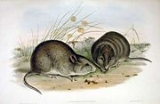
Broad-faced Potoroo
Encyclopedia
The Broad-faced Potoroo (Potorous platyops) is an extinct species of marsupial
that once lived in Australia
. The first specimen was collected in 1839 and described by John Gould
in 1844, but even then it was rare and only a handful of specimens were ever collected, the last in 1875. Subfossil remains indicate that it originally had an extensive distribution from the semi-arid coastal districts of South Australia
to the Western Australia
n coast, and possibly as far north as North West Cape
.
The habits of the Broad-faced Potoroo are almost entirely unknown. It is clear that it avoided the fertile forested areas that its relatives the Long-nosed
and Long-footed Potoroo
s inhabit. It is unusual amongst recently extinct Australian vertebrates in that it appears to have declined significantly before the European settlement of Australia.
Preserved specimens indicate that it was smaller than the other potoroo
s at around 24 cm long with an 18 cm tail. The coat was grizzled grey above and dirty white below, the body similar in shape to that of a large rat. The ears were small and rounded, the muzzle fairly short, and the cheeks notably puffy.
Marsupial
Marsupials are an infraclass of mammals, characterized by giving birth to relatively undeveloped young. Close to 70% of the 334 extant species occur in Australia, New Guinea, and nearby islands, with the remaining 100 found in the Americas, primarily in South America, but with thirteen in Central...
that once lived in Australia
Australia
Australia , officially the Commonwealth of Australia, is a country in the Southern Hemisphere comprising the mainland of the Australian continent, the island of Tasmania, and numerous smaller islands in the Indian and Pacific Oceans. It is the world's sixth-largest country by total area...
. The first specimen was collected in 1839 and described by John Gould
John Gould
John Gould was an English ornithologist and bird artist. The Gould League in Australia was named after him. His identification of the birds now nicknamed "Darwin's finches" played a role in the inception of Darwin's theory of evolution by natural selection...
in 1844, but even then it was rare and only a handful of specimens were ever collected, the last in 1875. Subfossil remains indicate that it originally had an extensive distribution from the semi-arid coastal districts of South Australia
South Australia
South Australia is a state of Australia in the southern central part of the country. It covers some of the most arid parts of the continent; with a total land area of , it is the fourth largest of Australia's six states and two territories.South Australia shares borders with all of the mainland...
to the Western Australia
Western Australia
Western Australia is a state of Australia, occupying the entire western third of the Australian continent. It is bounded by the Indian Ocean to the north and west, the Great Australian Bight and Indian Ocean to the south, the Northern Territory to the north-east and South Australia to the south-east...
n coast, and possibly as far north as North West Cape
North West Cape
North West Cape is a large peninsula of land in the north west coast of Western Australia. Cape Range runs down the spine of the peninsula and Ningaloo Reef runs along the western edge...
.
The habits of the Broad-faced Potoroo are almost entirely unknown. It is clear that it avoided the fertile forested areas that its relatives the Long-nosed
Long-nosed Potoroo
The Long-nosed Potoroo is a species of Australian potoroo. It is listed as Endangered in Victoria , Vulnerable in Queensland and nationally , although the IUCN lists it as Lower Risk.At first glance the Long-nosed Potoroo with its...
and Long-footed Potoroo
Long-footed Potoroo
The Long-footed Potoroo is a species of potoroo found in southeastern Australia, in a small area around the coastal border between New South Wales and Victoria. It was discovered in 1967 when an adult male was caught in a dog trap in the forest southwest of Bonang, Victoria...
s inhabit. It is unusual amongst recently extinct Australian vertebrates in that it appears to have declined significantly before the European settlement of Australia.
Preserved specimens indicate that it was smaller than the other potoroo
Potoroo
The Potoroo is a kangaroo/rat like animal about the size of a rabbit. All three extant species are threatened, especially The long-footed Potoroo and Gilbert's potoroo...
s at around 24 cm long with an 18 cm tail. The coat was grizzled grey above and dirty white below, the body similar in shape to that of a large rat. The ears were small and rounded, the muzzle fairly short, and the cheeks notably puffy.

